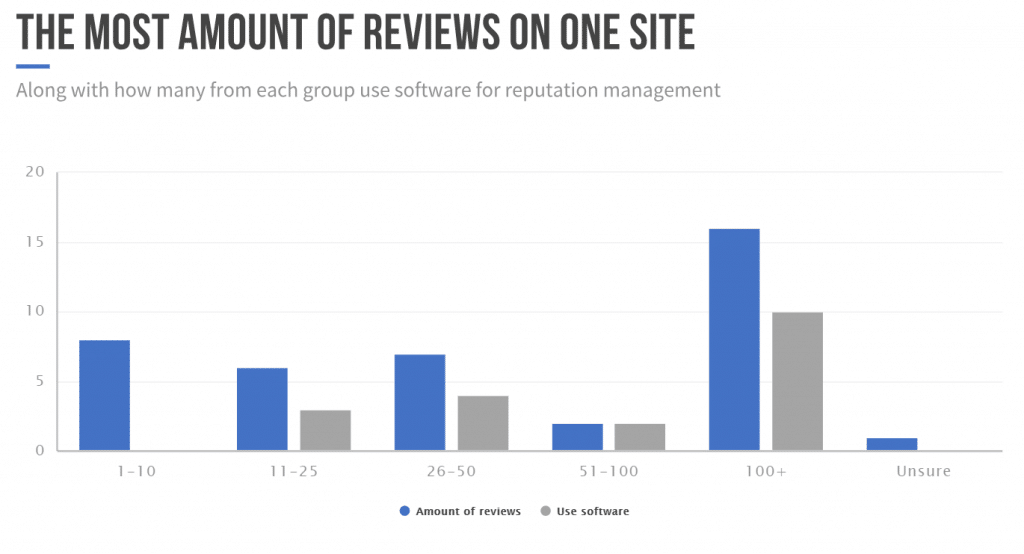People do a lot online. They shop, they research, they communicate, learn, and hang out in social settings – all online. Whether you’re an online-only business or not, you likely have some sort of online presence. Whether it be a social media page, website, or a list of reviews.
The truth is, all of these have an effect on your reputation. And how you manage and use these platforms can be great tools for your business.
But, just as easily as it is to use these channels to communicate with customers, and reach out to new leads, it’s just as easy to tarnish your name. People can easily write negative things about your business or customer service, which can have a huge effect on how well your business does. This makes it increasingly important to monitor your reviews.
Fortunately, as we have learned, there are a variety of options you have at maintaining a good reputation. But what are some things you can do if you do receive a bad review?
We published a survey to find out the secret to maintaining a good reputation (part one of this survey), and how marketers respond to bad reviews (which we will cover below).
Recap on what we found in part one
Just to give a quick recap on our survey findings, we recorded 40 survey responses from a variety of businesses (from SaaS, small businesses, to enterprises).
Here are some statistics we mentioned previously (find link in the section above) in part one.
- 90% or respondents said they handle their online reputation themselves
- 21 of the 40 respondents mentioned they used software (of which, Trustpilot was the most commonly used)
- Most people feel that the biggest benefit to using reputation management software is to handle negative content
The majority of people who use software have at least 10 reviews on at least one site
We found it to be really interesting that those who mentioned they used software had more than 10 reviews on at least one site. 78% of marketers said they had at least 10 or more reviews!
We asked: What’s the most amount of reviews you have on one site? And surprisingly, 40% of respondents mentioned they had 100 or more on at least one site.
As you can see, those who mentioned they had a higher amount of reviews, were more likely to also use software. In fact, at least half or more from each of the higher review groups used software for their online reputation management strategy.
Those who only had 1–10 or that were unsure of how many reviews they had mentioned that they do not use software to help with reputation management.
Meaning 38% of people who do not use software only had the most of 1–10 reviews on one site at a time.
40 marketers share tips for how to handle bad reviews
We split our data up into two parts. Part one covered brand reputation management strategy. Part two covers how to deal with negative reviews in order to keep your reputation up.
Our question was simple: What is your strategy when dealing with bad reviews? Here’s what we learned:
- Strategize to get the results you want
- Use the right tone when apologizing
- Reach out, but only when necessary
- Don’t shy away from apologizing publicly
- Don’t brush negative comments under the rug
- Don’t try to fix something by offering something you can’t promise
- Use negative reviews as a way to grow
- Always work towards a solution
- Be sure to investigate and then be proactive
- Use negative comments to fuel yourself forward
1. Strategize to get the results you want
You have to set up a strategy to get the results you want. That means coming up with something before negative reviews come in, as well as coming up with a plan on how to handle them, after the fact.

In this world of digital media, brand reputation management is a very sensitive area. A single negative review on customer review sites (like Amazon Customer Reviews, Google My Business, Or Yelp) can make things worse for your brand reputation. These negative reviews can even take their place at the top in google search unless you don’t manage your brand reputation effectively.
Therefore, it is better to first rank your informational content on Google. This way, your valuable informational content comes to the top and negative reviews go down.

An equally integral part of a successful brand reputation management strategy includes developing relationships with press outlets, community leaders and other organizations by establishing your brand as trustworthy and dependable in the quality it offers. Third-party endorsements lend credibility to your brand that ads — no matter how creative — can’t. Whether it’s how you publicly respond to your audience’s or what is published about your brand, brand reputation management — when done successfully — allows you to better control the narrative of your brand and ensures that the messaging you want to reach your audiences does.
Randy Mitchelson from iPartnerMedia
Fortunately, iPartnerMedia has no bad reviews. However, we work with clients who do. We have two main strategies to offer. First, every review, good or bad, should be treated as a gift. The review should be acknowledged and thanked and when necessary, an apology offered and a solution to discuss further via telephone to resolve. Second, our philosophy is that the best defense is a good offense. Online reviews is a numbers game. The more positive online reviews you earn the better the averages will work in your favor when bad reviews are mixed in. There are software solutions like ours that make it efficient to accelerate the acquisition of new reviews and manage them across channels.

Our main focus isn’t on building a good reputation by getting reviews. Our main focus is on doing a good job for our clients and being a reliable supplier in our industry. We get back to them to see what we did wrong and how we can fix their issue.
Use the right tone when apologizing
Sometimes it’s funny to be sarcastic. But, it may not work well for an apology. Make sure your tone, is sincere because if there is a chance it can be interpreted differently, it will be.

Never ignore a bad review – whether it’s constructive or simply just negative. Ensure your response always has a positive tone, understanding to those with genuine criticism, offering the chance to discuss any issues in a call, and polite but pragmatic with those who you feel just like to complain. Note that potential customers will not only read your reviews, but they will read your responses and a great response to a negative review could sway their opinion in the right direction.

Be genuine and grateful – No matter the review, the reason you have reviews in the first place is to get direct feedback from the people who matter most – your customers! Even a bad review should be appreciated because it should be a springboard for growth within your company. Good feedback is great, but negative feedback is crucial. Part of the ability to communicate directly with your customer is that they get to see that you’re a real person, not just a product. Leave out all the industry jargon and talk to them like you would a real person, with empathy and solutions!

Respond calmly, and wait to respond if you’re feeling upset by a bad review. Use that calm response to speak to their direct issue mentioned, and take the conversation offline. Nothing looks worse to a potential client than the business responding poorly to a review.

Our strategy has always been “kill them with kindness.” We don’t just copy/paste canned responses, but we address each individual by name and craft out a careful and thoughtful response. When we go above and beyond to show empathy, complaints are quickly resolved and sometimes reviewers will even delete their negative comments!
Reach out, but only when necessary
You may find that it’s beneficial to reach out to people who left a negative review. However, this might not always work. Sometimes, what is best is to just move on.

The strategy to deal with a bad review is to first mitigate the bad review from ever occurring. In the case the bad review goes online we have a customer relationship management representative that will contact the client to make sure that we can fix anything that caused the bad review. If any of our clients expresses anything less than perfect satisfaction, it is our duty to reach out to them, respond to their feedback, and make sure that they are happy enough to not only return as a client once again in the future, but to refer people in their network to us.

Remember to give yourself some time to calm down before you respond to a negative review. The last thing you want is to write something you’ll regret in the heat of the moment. After you’ve taken some time to relax, read through their review and see if there is some merit to what they are saying. Regardless of how you feel, take time to thank them for their feedback. Then offer to try to resolve the issue with them and invite them back in an effort to improve their future experiences. If they are still unhappy with you and unwilling to take you up on the opportunity to make things right, let it go.

We always reach out to see if we can remedy any dissatisfaction. Sometimes mere acknowledgement that you are willing to rectify a perceived problem shows good faith ameliorative efforts that can diffuse customer dissatisfaction.

We treat each review with the attention we think it deserves but we do not respond to all negative reviews. Especially on sites with other positive reviews, it’s usually better to say nothing. Most people understand that you can’t please everyone.

First, thank the customer for taking the time to give a bad review. Then, offer a sincere apology then try to ask for the root cause for the dissatisfaction. In our experience, the fact that an organization cares enough to reach out to the dissatisfied customer is often enough to start the healing process. Many times, the customer will add or edit the bad review to turn it into a good one – and becomes a long term customer and brand ambassador for the organization.
Don’t shy away from apologizing publicly
An apology can make a big impact if done publicly. For instance, if someone writes a review online, you can start a thread directly on their review and apologize. This can save face and show others that you handle situations accordingly.

When we have a bad review we like to handle the matter publicly where posted. We like to accept responsibility where we can with the issue, acknowledge the impact of the problem, and publicly offer ways to create a solution that benefits the client. Handling bad reviews publicly allows potential customers to understand that we care about the satisfaction of our clients and are actively working to create a better experience for future clients.

Find the reviewer, refund or replace depending on the nature of the review. Offer other products from the line free of charge, offer to replace or fix anything that was damaged by our product. We also respond to every negative review publicly. Even though the original poster won’t see it – we feel that future shoppers will interpret our response as a sign that we’re trustworthy.

People will be even more curious to find out why is there a bad review. Thus, responding respectfully – somewhat stoic – helps to mellow things. Also, you can provide a specific clarification to why that situation happened and how your company is taking care of it with utmost responsibility, professionalism, and effectiveness. By doing this, you’ve actually dispelled one risk that prospects might think about later in the sales funnel. This tactic is part of copywriting, also known as risk reversal.

In the unfortunate event that you receive a negative review, it’s important to research what happened and respond in a polite, personalized manner while attempting to diffuse the situation and fix the problem. Simply ignoring a negative review can look bad from the public’s perception. We take the same approach regardless of the platform, because we want to fix the problem from a fundamental standpoint. If we’re able to use negative reviews to make ourselves better, then we can continue to grow as a business and serve our customers better.
Don’t brush negative comments under the rug
You may be able to ignore comments every once in a while. But, for the most part, you’ll want to avoid brushing off too many negative comments. This can be seen ad neglectful on your part.

Don’t ignore them! By responding you get the opportunity to change someone’s mind. Avoid using stock phrases and copy pasted responses – no one likes to hear ‘lessons will be learned’ because no one believes that it’s true. Customize your response to the person you’re speaking to, and actually implement any changes that you promise to.
It’s also important that you respond publicly, even if it’s just to apologize and say that you’ll contact them directly – this shows future guests that their experiences are important to you. An unattended negative does nothing helpful for your business, a proper response and action could see you retaining the customer, and encourage new people who trust you.

We quickly investigate the issue to understand the full set of facts. We respond online with an honest answer – admitting culpability when needed. We try to clarify miscommunications and be as honest and transparent as possible. If we can identify the reviewer, we also try to respond offline by emailing or calling to get more feedback and rectify the situation as best we can.

Approaching each bad review or unhappy user at a personal level is really important. Bad reviews may seem like they’re only negative for your brand, but you might actually be able to learn a lot from them. Talk to them personally, find out what went wrong, and identify a specific way you can make things better.

The best strategy when dealing with bad reviews is first, don’t be afraid of them and secondly always responding to them. We care about what people think about our service, what issues they have, and what they would like to be improved. And showing our intentions and concern to our customers has yielded spectacular results.

Do not ignore negative comments and reviews. Be mindful with your response. Never react with anger or get into a comment battle. This is tacky and immature. Admit to your mistakes and seek ways to improve. Try to turn this negative into a positive – if you can react in a way that is positive and productive, you can turn an unhappy customer into one of your biggest cheerleaders. This is a win for both parties.
Don’t try to fix something by offering something you can’t promise
We all want to go above and beyond. But, if you’re offering something back that you can’t actually deliver you will run into more problems than you started with.

Take the fact out they wrote a negative review out of the equation. Don’t take bad reviews personal. It is easy to hold a review against a customer, which may hinder a resolution. If a negative reviewer deserves a refund, do it. Do what is right but at the same time, if you cannot resolve the situation, do not give the reviewer that impression that it can be fixed in the review response.

The best way to deal with bad reviews and poor press is to prevent it from happening in the first place. However, it is impossible to eliminate this issue completely, so my strategy is to address the problem and apologize if necessary. Be authentic in your response and is possible, respond to the customer directly and privately to increase their trust in you.

Firstly, respond as quickly as you possibly can. Even if you don’t have an answer, let the complainant know that you are gathering information to deal with their grievance. Don’t make excuses, offer solutions; aim to resolve the problem as soon as possible and do not go into too much detail as to why the problem occurred – this can only count against you.
Focus on improving their experience and ensuring their problems are fixed. If the complaint is made on a public forum, such as your website or on social media, make sure you also comment once the issue is resolved. This will show the outside world that you tackled the problem for the customer and helps to soothe the situation.
Use negative reviews as a way to grow
You might be able to learn a lot from a negative review. Like if someone has concerns about your sales process or even the length of delivery, you may be able to find a better way at handling these situations to avoid other negative reviews.

We respond as quickly as possible, and try to resolve their issues. Our dev team values negative reviews, as many times it brings light to a larger problem.

We like to engage the client, and get more details as to why they had a bad experience. We really want to learn from our mistakes, and most importantly, own up to them and apologize. This shows other consumers that we are human, and make mistakes. Hopefully that consumer will see that we took time to address the concerns, and that we do in fact care about reviews from people who were not happy with us. In some cases, we even send out Starbucks or Amazon gift cards to people who had a bad experience.

We advise clients to respond to unfavorable reviews in a timely and courteous manner, rather than ignoring them. If a complaint is valid, the first thing to do is address the issue in question. Holding your hands up to an error, then communicating the measures you have put in place to rectify the issue will go a long way. Nobody is immune to mistakes, but how you respond to them will define public perception. You may not agree with the criticism being leveled at you, but engaging in a war of words will never reflect well on your brand. A visible willingness to communicate further is enough to show you are professional and approachable should a negative situation arise in the future.

First of all, it’s important to understand that everyone gets a bad review from time to time. It might not even be your fault but simply a client who was in a terrible mood and your product was the easiest to blame.
The secret is, again, empathy. Put yourself in your client’s spot and try to understand that a bad review is not personal. This will give you the calm necessary to formulate a polite, empathetic answer that shows that you are trying to fix the issue. Never, under any circumstance, delete or ignore a bad review – this will look irresponsible to any prospective clients. And you never know – one man’s negative might be another man’s positive.
Always work towards a solution
A great way to make your apology stick is by offering a solution. If you don’t know one right away, always mention that you are working towards it. A quick ‘sorry’ might not cut it.

Depending on the type of review, it’s always best to ask questions and get to the bottom of the issue. You can’t fix what’s already broken, but you can resolve it with alternatives to win people over. Or at least get on the same page so there’s no animosity or anything similar.

When having a bad review, the first thing that we do is to find out the reason why our customers feels angry. Maybe he has all the rights to get angry at our company and write a bad review? After investigating the issue we start thinking what’s the best value, that we can give to our customer and solve his/her issue?
It’s a really hard job, because sometimes customers can get very angry for a single issue on your website and fixing everything and calming down the customer takes time. And as a conclusion, everything is possible. If you know what your customers really need at the moment, than you have all the chances for getting his/her trust back.

It’s crucial to be honest and grounded in your responses to customers, whether they’re positive or negative reviews. If there was truly a mistake or poor service on part of your business, accept responsibility and apologize sincerely. Then make an effort to mend the harm and reassure the customer of how your business is preventing similar instances moving forward. If a customer is being rude or untruthful, keep your response short, sweet, and professional. Never retaliate or stoop to the negative level of a bad review.

Unfortunately most of our “bad” reviews are not from customers, but from truck drivers waiting to unload at our warehouses. This is a new trend as drivers are under so much pressure to make as many deliveries as possible. There is a national shortage of drivers which makes their jobs even harder and they become frustrated while they wait. We are looking into ways to make them more comfortable and do what we can to accommodate them.
Be sure to investigate and then be proactive
Disgruntled employees and those who have it out for you can write negative and malicious reviews. Be sure to investigate if necessary. If out of nowhere you have a ton of negative reviews you may have to get them removed. Also, it’s probably a good idea to avoid confrontation in these instances, in order to avoid further damage.

Whenever we receive a negative review, our strategy is threefold: acknowledge the source of the complaint, present our side of the situation, and provide an action plan to ensure the issue does not occur again. Mistakes happen and this shows our commitment to preventing re-occurrences.

When possible, look at the platform they are on and what the specific terms are for reporting a review and getting it invalidated. In other cases, show you made amends or respond showing the reviewer is in the wrong and not your company. You can also reach out to individuals, make amends, and then have them change their review.

Generate new content or reviews to push the bad ones down and/or get the bad ones removed if you can show the site that trolls are stalking you online.
Use negative comments to fuel yourself forward
If you play your cards right, your response to a negative review can push your brand forward. You can establish trust along with give future customers a sense of your customer service.

I make content out of them. For example, if I get an email from a customer complaining about something, I will copy and paste it and send it out to my email list. I will often joke about it and it almost always leads to more sales. Like I said, customers understand that there are some bad apples out there who will always complain. The key is to take the negative review and turn it into a reason to buy. For example, if someone complains about how long your product takes to ship, you can turn that into a reason to buy (i.e. it’s worth the wait). You can tell your customers up front that if they aren’t willing to wait, then your product is not for them and they shouldn’t buy.

Really read them. Understanding what your readers/users are dissatisfied with is important to improving your business. If you receive a particularly scathing review or comment or press mention, step away before you decide how to react.

First and foremost we speak directly to the customer, thanking them for their business and for trying our products. We then address their concerns and/or issues while offering them any information or solutions that we think may enhance their experience with the product or at the very least offer them satisfaction with their business with us. We believe this is the best method of dealing with bad reviews as it shows that we are a company open to communication and aren’t afraid of bad reviews or feedback. We believe that even if there isn’t a solution for their issue with the product, that we want the customer to walk away from the interaction with us feeling respected and treated properly.

We reach out to see how we can make things right not only for that client but to help prevent any issues in the future.
In conclusion
Having a strategy for how you handle negative reviews is essential. Reaching out and making things right seems to be the main take away, but it’s also important to understand that you may not be able to please everyone.
In such cases, you need to do a little bit of research and you may find in extreme cases that deleting or removing malicious comments is the best option. In most cases, however, you’ll find that simple apology can be most beneficial. As people often read how you respond to these types of reviews to get a feel for how your business operates. In any case, don’t brush a bad review off. Instead, use it as an opportunity to grow.






